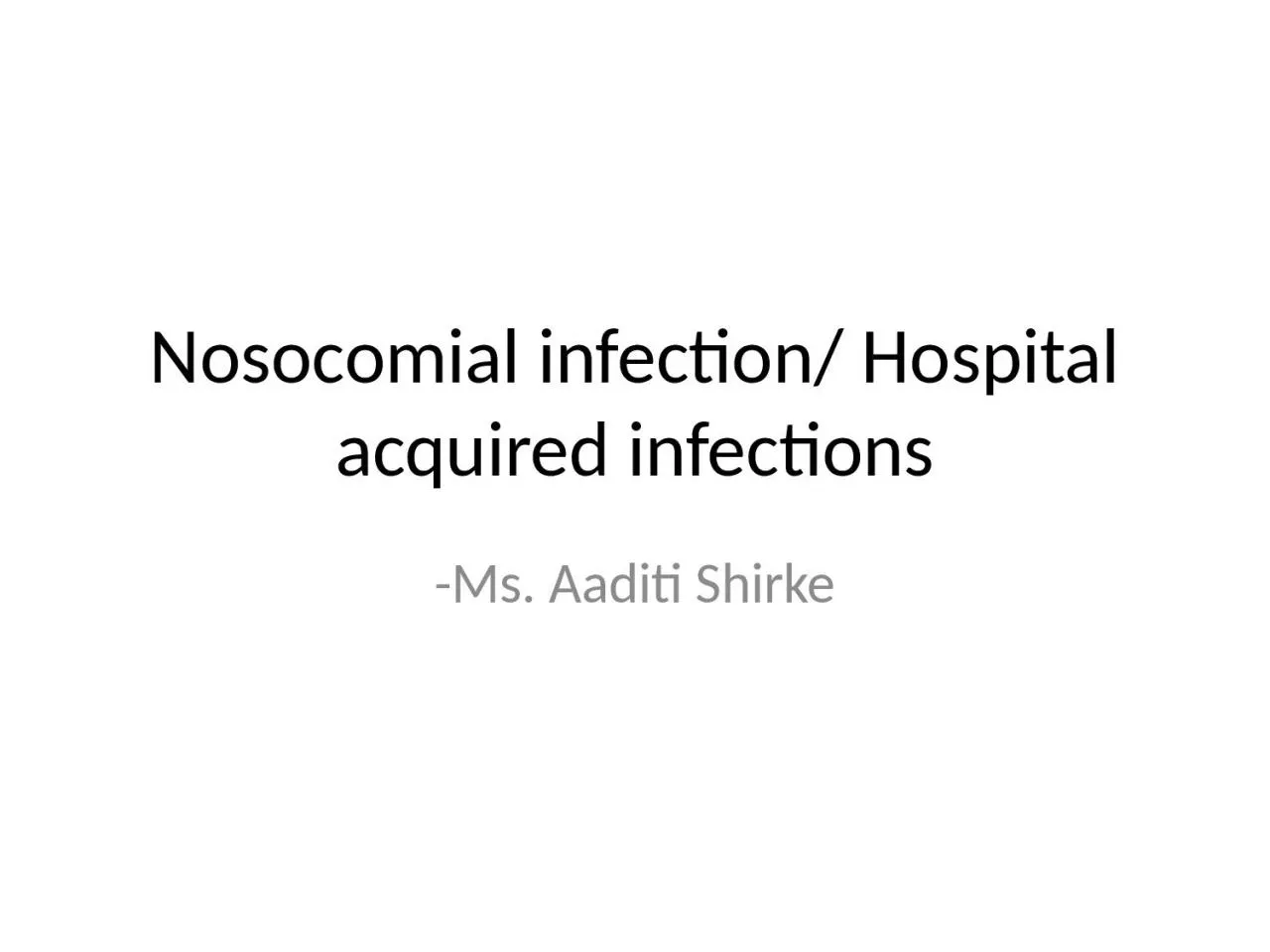

Ms Aaditi Shirke Objectives At the end of the lecture the student would be able to 1Define Nosocomial infections 2 Demonstrate the main clinical characteristics of Nosocomial infections ID: 1009349
Download Presentation The PPT/PDF document "Nosocomial infection/ Hospital acquired ..." is the property of its rightful owner. Permission is granted to download and print the materials on this web site for personal, non-commercial use only, and to display it on your personal computer provided you do not modify the materials and that you retain all copyright notices contained in the materials. By downloading content from our website, you accept the terms of this agreement.
1. Nosocomial infection/ Hospital acquired infections-Ms. Aaditi Shirke
2.
3. ObjectivesAt the end of the lecture the student would be able to: 1-Define Nosocomial infections. 2- Demonstrate the main clinical characteristics of Nosocomial infections. 3-Point out the occurrence of the disease. 4-List the causative agents, mode of transmission, and incubation period of Nosocomial infections. 5-Define the control strategies of Nosocomial infections. 6-List the main preventive measures of Nosocomial infections.
4. Definition An infection occurring to a patient in hospital or other health care facility in whom it was not present or incubating at the time of admission or the residual of an infection acquired during a previous admission.
5. Includes: infection acquired in the hospital but appearing after discharge & also infections among the staff of the facility Occurs at rate of approximately 5- 10% admission in some hospitals Occurs at rate of approximately 5- 10% admission in some hospitals Many
6. Nosocomial infections are associated with an : Many nosocomial infections are associated with an : Extended length of stay Substantial morbidity & Prolonged therapy
7. Sources of InfectionThe source of the infecting organisms may be exogenous from another patient or a member of the staff or from the inanimate objects in the hospital like medical equipments (endoscopes, cystoscopes, catheters, needles,etc.)Bedpans, food, water, hospital air, and surfaces contaminated by patients sereations, blood & body fluids.
8. It may be endogenous from the patients’s own flora which at the time of infection may invade the patients’s tissue spontaneously or be introduced into them by surgical operation, instrumental manipulations or nursing procedure.
9.
10.
11.
12. Nosocomial Infection SitesUrinary infection Surgical site infectionNosocomial pneumoniaNosocomial bacteraemiaSkin & soft tissue infectionGastroenteritis Endometritis
13.
14.
15.
16.
17. Routes of Transmission of infection in HospitalContact spread:It is the principal route of transmission of nosocomial infections.It may be direct contact spread from person to person. Staphylococcus aurous & Streptococcus pyogenes are two important pathogens spread by hand contact. Certain equipments (endoscope, bronchoscope, cystoscopes), if not properly disinfected, may transmit pathogenic organisms, eg. Pseudomonas aeruginosa.
18. 2) Airborne Spread:Hospital infection nay be acquired by inhalation of droplets, droplet nuclei, dust from bedding & floors, & exudates dispersed from a wound during dressing. Aerosols produced by nebulizer, humidifiers, and AC apparatus transmit certain pathogens like Legionella to the respiratory tract, because these organisms are widespread in water including portable water supplies.
19. Occurrence of legionellae in hospital water supply, & a number of persons with an impaired immune system has led to outbreaks of infection mainly with Legionella pneumophila, but also with L. Nosocomial infection occurs in patients rather than in staff who generally have circulating antibodies, which suggest exposure.
20. 3) Oral Route: Gastrointestinal pathogens may be transmitted by food served to the patients. Hospital food may also be a source of antibiotic-resistant bacteria (Pseudomonas aeruginosa, Escherichia coli, Klebsiella spp. & others), which may colonize the gut & later cause infection in susceptible patients.
21. 4) Parenteral route (inoclusion): With the single use disposable needles, syringes & other devices & satisfactory procedure for the sterilization of surgical instruments, transmission by parenteral route has been infrequent.
22. Certain infections may be transmitted by blood transfusion or tissue donation, contaminated blood-products, contaminated infusion fluids & from accidental injury with contaminated sharp instruments (AIDS, Hepatitis B & C).
23. 5) Self-infection: Self infection may occur due to transfer into the wounds of staphylococci & streptococci carried by the patients in his nose & over his skin, or of coliform bacilli & anaerobes released from his bowel during surgery.
24.
25. Common nosochomial infections cont---
26. Common nosochomial infections cont---
27.
28. Why should we prevent HAINosocomial infections lead to :Increased healthcare costs, Extended hospital stays. Prolonged recovery time.Cause disability and discomfort.Loss of life.
29.
30.
31. Members of HICC
32. Functions of HICC
33. Functions of HICC Cont---
34.
35. Hospital infection strategies cont---
36. Hospital infection strategies cont---
37.